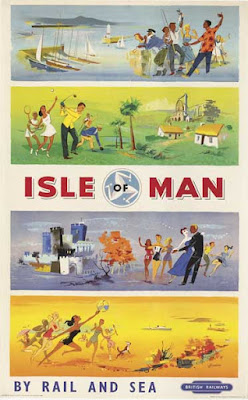In 2011 I posted a short essay entitled
‘Haydn
Wood: the Isle of Man Works’. In this note I listed Wood’s music inspired by
this lovely island. At that time, three of these works had not been recorded. So,
it was with great delight that I discovered the beautiful Manx Country Sketches (1943) on the recent Dutton Epoch CD of the
composer’s Orchestral Suites.
It will be recalled that although Wood was born in Slaithwaite (not pronounced as it is spelt) in the West
Riding of Yorkshire, he moved to the Isle of Man with his parents when still a
schoolboy. He was later to work there for several years as musical director of the
Palace & Derby Castle Company.
Marjorie Cullerne and Tony Clayden
explain in the CD liner notes that the young Haydn Wood matured musically in
the 1880s and 90s in Douglas, where a large number of holidaymakers, mainly from
the north of England, were having a huge impact on musical taste on the Island.
Wood was to understand the ‘popular’ aspirations of these visitors. On the
other hand, he had a huge respect for the then-dying traditional Manx songs. At
the same time the language was also disappearing (fortunately now being revived).
In Wood’s day several songs had been collected and published. He was keen to
use these ‘traditional tunes’ in his Manx-inspired music.
I have only been to the Isle of
Man on a couple of occasions. Yet this present work strikes a chord with me. I
recall walking on Spanish Head in the south of the island one summer’s night.
It was nearly dark, and we could see all Six Kingdoms – Blackpool Tower and the
Pleasure Beach (England), the Mull of Galloway lighthouse in Scotland, the glow
of Larne in Ulster, the beacon light off Anglesey (Wales) and the Isle of Man
itself. But then there was the sixth – the Kingdom of Heaven! – Not to mention
anything about the realm of the fairies or folklore and ancient traditions. All
this magic, I am sure, was in the thoughts of the composer as he wrote this lovely
work.
The only problem with Manx Country Sketches is that it is too
short. The opening piece, ‘A Manx Pastoral Scene’ lasts for a mere three and a
half minutes. Yet the style and mood are that of a small but brilliantly
crafted tone-poem that perfectly imagines the beautiful Manx countryside. The
orchestration of this piece is a masterclass in creating a mood: ‘shimmering’
and ‘translucent.’ I do not know if this piece is based on an original folk
tune. This idyll was inspired when the composer went on long, solitary walks.
The second of the two pieces, ‘A
Manx Country Dance’ is based on the tune ‘Hunt the Wren.’ We will draw a veil over
the less-than-environmentally correct origins of this tune and how it used to be
used in celebrations. This pre-Christian, Pagan tradition, which occurs on Boxing
Day (St Stephen’s Day) is now guaranteed not to harm any living
creature! Haydn Wood has used the ‘energetic’ jig tune throughout the piece. The
liner notes point out the ‘allegro moderato’ tempo of the music and suggests that
the composer was ‘envisioning it for traditional circle dancing.’ It is a
neatly orchestrated piece that is full of vibrancy and subtle humour.
From my reckoning, the only Isle
of Man works now needed to complete the set are King Orry (1939) and A
Pageant of the Isle of Man (1951). Fingers crossed!
Haydn Wood: Manx Countryside Sketches are recorded on Dutton
Epoch CDLX 7357. The CD includes the Festival March, the Snapshots of London
Suite, the Cities of Romance Suite and the Royal Castles Suite.

No comments:
Post a Comment